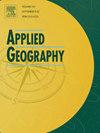个体日常活动的空间固定性是如何长期演变的:一个生命历程和多尺度行为解释
IF 5.4
2区 地球科学
Q1 GEOGRAPHY
引用次数: 0
摘要
空间固定性是衡量个人活动局限于特定地点的程度,是日常活动地理学研究的核心。尽管最近的研究已经确定了导致日常活动空间不变性的因素,但缺乏纵向观察来了解其在较长时间框架内的演变。为了解决这一研究缺口,本研究引入了一个整合多尺度个体行为的框架,以调查人们日常活动空间固定性的长期演变,从生命历程的角度提供了见解。该研究利用不同年龄组的290679人的手机数据,评估了他们在2019年10月至2020年10月以及2019年10月至2023年5月期间的活动模式变化。结果表明:(1)个体日常活动空间固定性随年龄呈u型分布,其中30 ~ 34岁年龄组固定性最低;随着时间的推移和个体过渡到特定的年龄阶段,可以观察到一致的空间固定性水平。(2)多尺度行为框架解释了1年和4年时间间隔内超过40%的日常活动空间固定性变化,强调了在较长时间内整合高尺度行为动态的重要性。(3) 35岁前后行为变化趋势明显,空间固定性演化呈u型曲线。这项研究促进了我们对人类流动性长期动态的理解。这些发现为加强个人行为建模、解决人口统计数据收集的延迟问题以及为有针对性的社会政策提供了有价值的见解。本文章由计算机程序翻译,如有差异,请以英文原文为准。
How spatial fixity of individual daily activities evolves in the long-term: A life course and multi-scale behavior explanation
Spatial fixity, measuring the extent to which individual activities are confined to specific locations, is central to geographical studies on daily activities. Although recent studies have identified factors contributing to the variability of daily activity spatial fixity, there is a dearth of longitudinal observations to understand its evolution over extended timeframes. Addressing this research gap, the study introduces a framework that integrates multi-scale individual behaviors to investigate the long-term evolution of peoples daily activity spatial fixity, offering insights from a life course perspective. Using mobile phone data of 290,679 individuals across different age groups, the study assessed changes in their activity patterns from October 2019 to October 2020 and from October 2019 to May 2023. Three major findings were derived from Difference-in-Difference modeling and behavior grouping: (1) Individual daily activity spatial fixity exhibit a U-shaped distribution with age, revealing the 30–34 age group with the lowest fixity. Consistent levels of spatial fixity are observed as time progresses and individuals transition into specific age stages. (2) The multi-scale behavior framework elucidates over 40 % of the variation in daily activity spatial fixity over one and four-year intervals, and the result highlights the significance of integrating higher-scale behavioral dynamics over extended period. (3) Distinct behavioral change trends before and after the age of 35 result in the U-shaped curve of spatial fixity evolution. The study advances our comprehension of the long-term dynamics of human mobility. The findings provide valuable insights for enhancing individual behavior modeling, addressing delays in demographic data collection, and informing targeted social policies.
求助全文
通过发布文献求助,成功后即可免费获取论文全文。
去求助
来源期刊

Applied Geography
GEOGRAPHY-
CiteScore
8.00
自引率
2.00%
发文量
134
期刊介绍:
Applied Geography is a journal devoted to the publication of research which utilizes geographic approaches (human, physical, nature-society and GIScience) to resolve human problems that have a spatial dimension. These problems may be related to the assessment, management and allocation of the world physical and/or human resources. The underlying rationale of the journal is that only through a clear understanding of the relevant societal, physical, and coupled natural-humans systems can we resolve such problems. Papers are invited on any theme involving the application of geographical theory and methodology in the resolution of human problems.
 求助内容:
求助内容: 应助结果提醒方式:
应助结果提醒方式:


